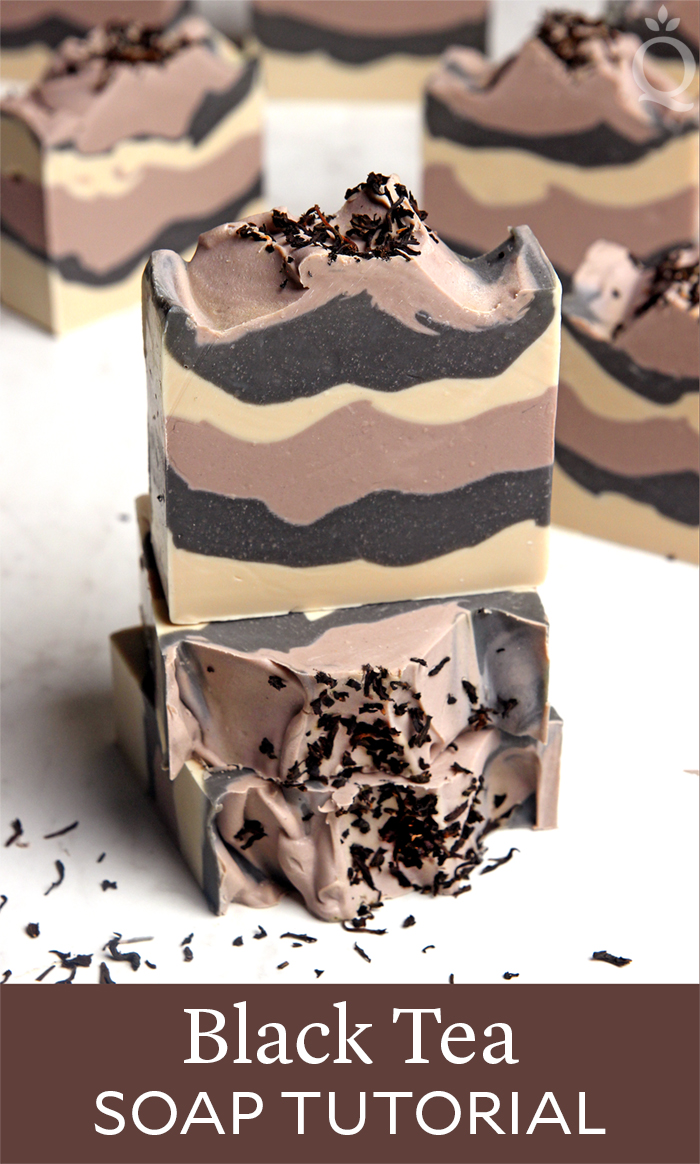 Black tea has been renowned for centuries as a potent source of powerful antioxidants. This Black Tea Cold Process Soap recipe harnesses those properties by replacing water with black tea. It’s also scented with the new Bergamot Black Tea Fragrance Oil. The fragrance is a complex blend of smoky tea leaves and bright bergamot with a subtle base of amber. It’s a fantastic uni-sex fragrance oil.
Black tea has been renowned for centuries as a potent source of powerful antioxidants. This Black Tea Cold Process Soap recipe harnesses those properties by replacing water with black tea. It’s also scented with the new Bergamot Black Tea Fragrance Oil. The fragrance is a complex blend of smoky tea leaves and bright bergamot with a subtle base of amber. It’s a fantastic uni-sex fragrance oil.
If you’ve never replaced water in your recipe with tea, it’s easier than you think. Simply brew the tea, allow it to cool and mix in the lye like you would with water. The lye solution will become a dark brown, so this recipe contains titanium dioxide to lighten the color. Purple Brazilian clay adds a natural purple hue, while activated charcoal gives a deep grey color.
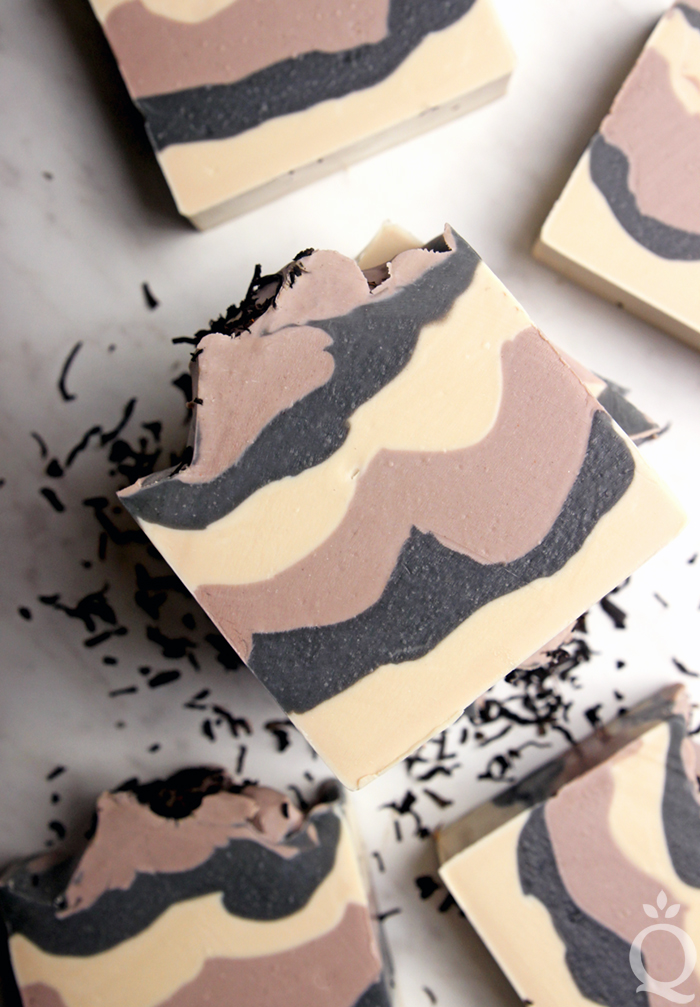
Because this recipe does contain plenty of titanium dioxide, it has a 20% water discount. The first time we made the soap without a water discount, we got a lot of glycerin rivers (Learn more about glycerin rivers here.) The water discount — or in this case, tea discount — eliminated them completely. The discount also helps to achieve a thick, easy-to-layer texture.
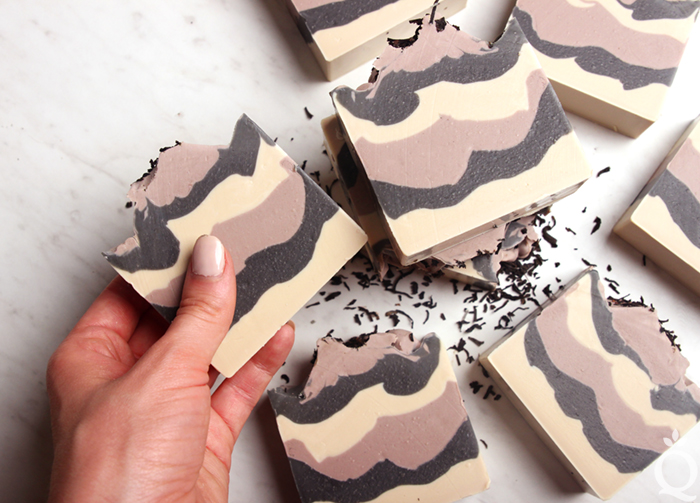
What You Need:
5 Pound Mold with Sliding Bottom
Silicone Liner for 5 Pound Mold
2.7 oz. Cocoa Butter (5%)
13.5 oz. Coconut Oil (25%)
2.7 oz. Matcha Green Tea Butter (5%)
16.2 oz. Olive Oil (30%)
13.5 oz. Palm Oil (25%)
5.4 oz. Sweet Almond Oil (10%)
14.3 oz. Brewed Black Tea (20% water discount)
7.6 oz. Sodium Hydroxide Lye
2 oz. Bergamot Black Tea Fragrance Oil
Titanium Dioxide
Activated Charcoal
Purple Brazilian Clay
Black Tea Leaves (for the top & to brew tea)
Large Sealable Tea Bag (for brewing tea)

Click here to add everything you need for this project to your Bramble Berry shopping cart!
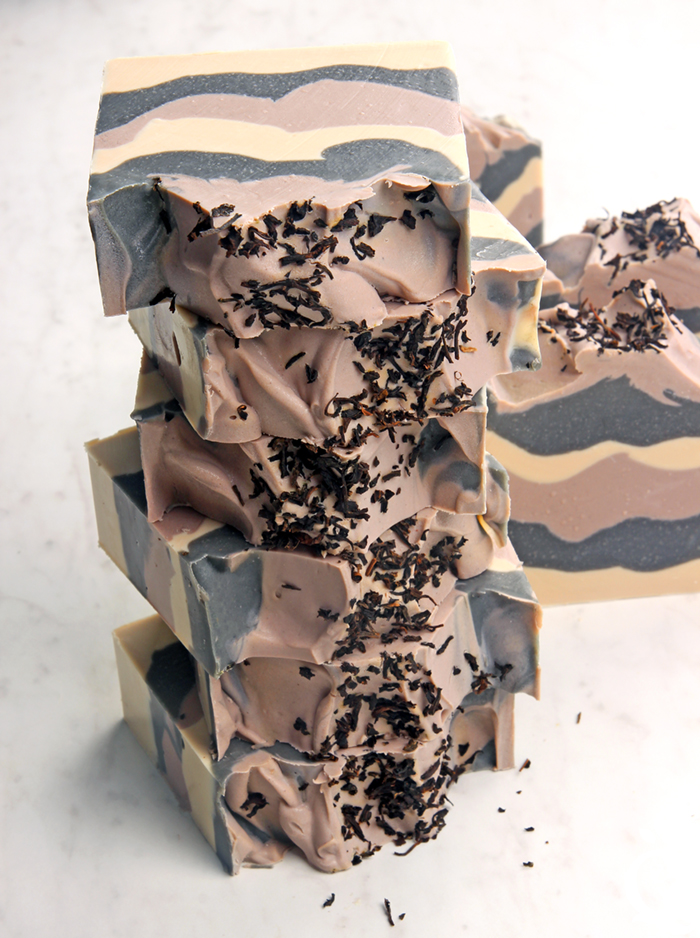
If you've never made cold process soap before, stop here! I highly recommend checking out our FREE four part SoapQueen.tv series on Cold Process Soapmaking, especially the episode on lye safety. Or if you'd prefer to read, Bramble Berry carries a wide range of books on the topic, including my newest book, Pure Soapmaking. You can also checkout the digital downloads for that instant gratification factor.
SAFETY FIRST: Suit up for safe handling practices! That means goggles, gloves and long sleeves. Make sure kids, pets, and other distractions and tripping hazards are out of the house or don't have access to your soaping space. Always soap in a well-ventilated area.
COLOR PREP: To ensure that the titanium dioxide blends smoothly into the soap batter, we recommend micronizing it before dispersing it in oil. Please note this is an optional tip but it does help with the titanium dioxide clumping in the soap.To micronize colorant, simply use a coffee grinder to blend the colorant to break up any clumps of color and prevent streaks of white from showing in the final soap. We like to use a coffee grinder that has a removable, stainless steel mixing area for easy cleaning. Then, disperse 3 teaspoon of the colorant into 3 tablespoons of sunflower or sweet almond oil (or any other liquid oil). Disperse 1 teaspoon of activated charcoal into 1 tablespoon of liquid oil. Use a mini mixer to work out any clumps. Then, disperse 3 teaspoons of purple Brazilian clay into 3 tablespoons of distilled water. Because clays absorb moisture, we recommend dispersing them in water rather than oil. Use a mini mixer or small spoon to disperse the clay.
FRAGRANCE PREP: Measure 2 ounces of Bergamot Black Tea Fragrance Oil into a glass container that is safe for use with fragrance oil. Set aside.
BLACK TEA PREP: First, boil 16 ounces distilled water to prepare the tea. It’s best to prep more tea than you need, because you will lose some during the steeping process. Add 4 tablespoons of black tea into the Large Sealable Tea Bag. If you’d like the tea to be stronger or lighter, you can use more or less tea. Iron the tea bag closed, and place in the hot distilled water.
Allow the tea to steep and cool for about 1 hour. Remove the tea bag and wait for the tea to cool to about 70 ° F. The cooler the mixture, the lighter the color of the lye mixture will be.If you'd like, you can also freeze the tea and add the lye to the frozen tea, similar to adding lye to milk, as shown here.
Measure out 14.3 ounces of tea. If you don’t have enough, add more distilled water. Save the tea leaves to place on top of the soap if you’d like. Place them on a paper towel to dry until you’re ready to use.
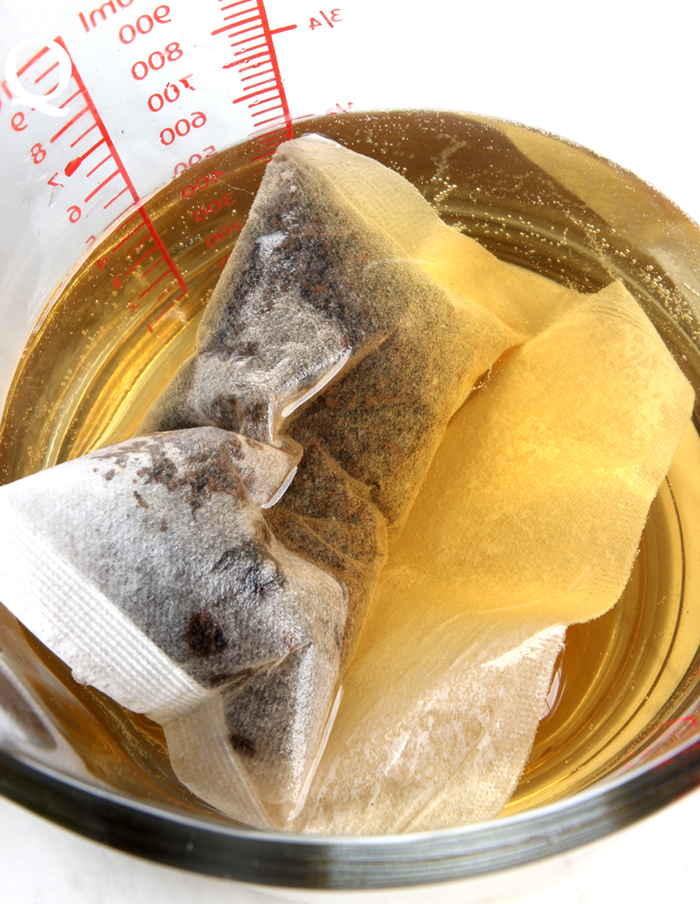
ONE: Slowly and carefully add the lye to the black tea and gently stir until the lye has fully dissolved. The mixture will be a brown color. Do not panic. That's what the titanium dioxide is for. Set aside to cool.
TWO: Fully melt the coconut oil, olive oil, cocoa butter, matcha green tea butter, sweet almond oil, and palm oil. Remember to fully melt and then mix your entire container of palm oil before portioning. Once the lye water and the oils have cooled to 130 degrees or below (and are ideally within 10 degrees of each other), add the lye to the oils and stick blend until you have a thin trace. If you'd like a harder bar of soap that releases faster from the mold, you can add sodium lactate to the cooled lye water. Use 1 teaspoon of sodium lactate per pound of oils in the recipe. For this recipe, you'd add about 3.5 tsp. of sodium lactate.
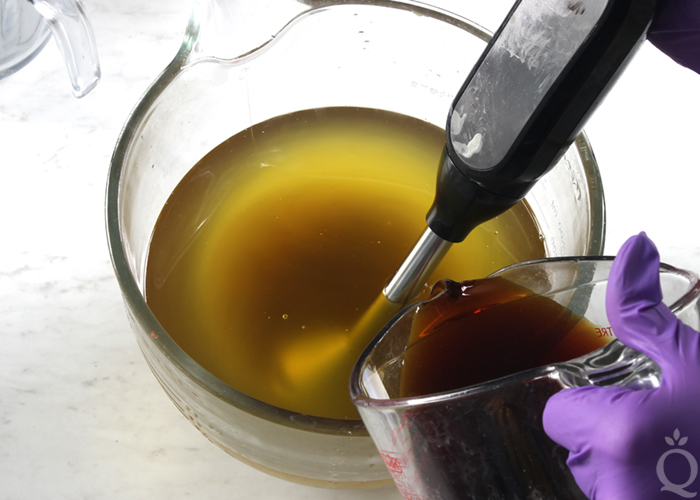
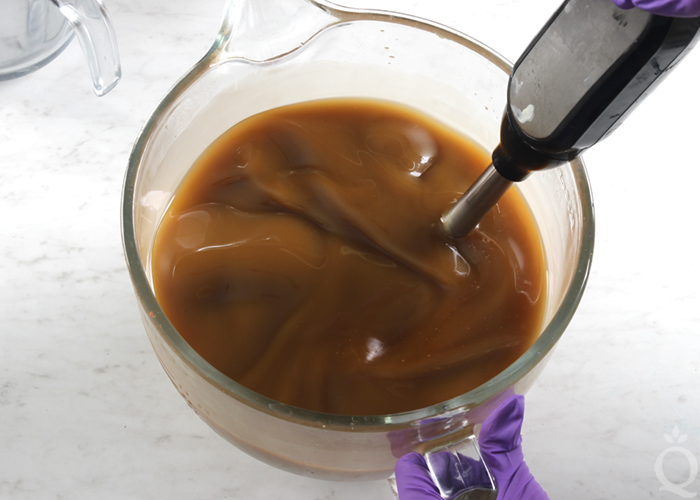
THREE: Once you reach a very thin trace, add all the Bergamot Black Tea Fragrance Oil. It’s okay to add the fragrance at the beginning because it behaves very well in soap.
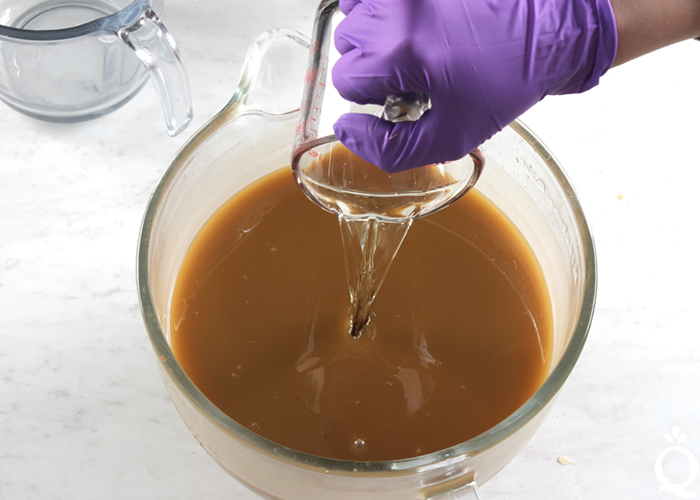
FOUR: Split off about 26 ounces of soap into a separate container. Add 2 teaspoons of dispersed activated charcoal, and use a whisk to fully mix in. Set aside.
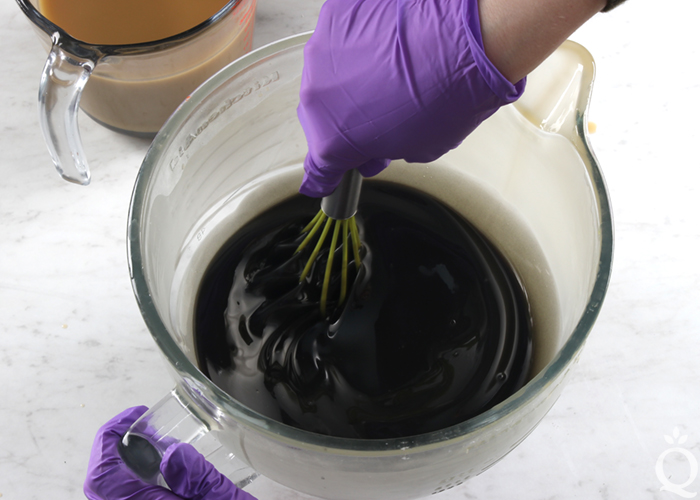 FIVE: Add all the dispersed titanium dioxide into the large amount of remaining soap. Use the stick blender to fully incorporate the titanium dioxide. Then split the batch in half. Each should weigh about 26 ounces. Add all the dispersed purple Brazilian clay to one container. Use the stick blender to incorporate the clay. Leave the other container of soap uncolored.
FIVE: Add all the dispersed titanium dioxide into the large amount of remaining soap. Use the stick blender to fully incorporate the titanium dioxide. Then split the batch in half. Each should weigh about 26 ounces. Add all the dispersed purple Brazilian clay to one container. Use the stick blender to incorporate the clay. Leave the other container of soap uncolored.
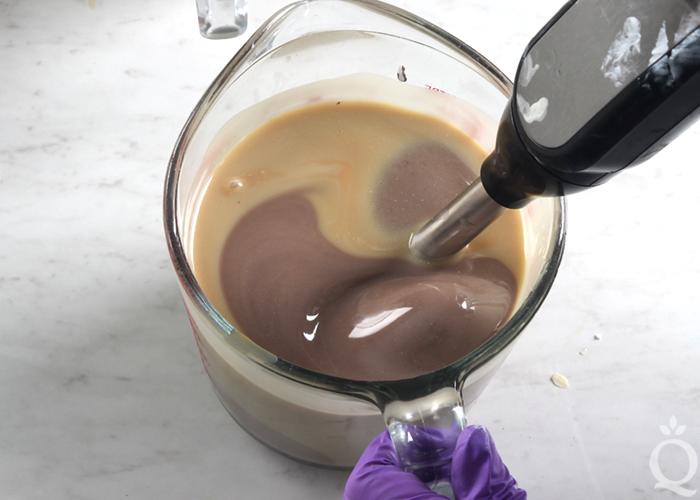
SIX: Now it’s time to start layering! First, make sure all the colors of soap are a medium to thick trace. Stick blend each from lightest to darkest until a medium to thick texture is achieved. Because they all have different amounts of various colorants, they may thicken at different rates.
SEVEN: Once you’re happy with the texture of each color, pour half of the uncolored soap into the mold and use a spoon to even it throughout the mold. Use the spoon to give the layer texture, because this design does not need exact straight layers.
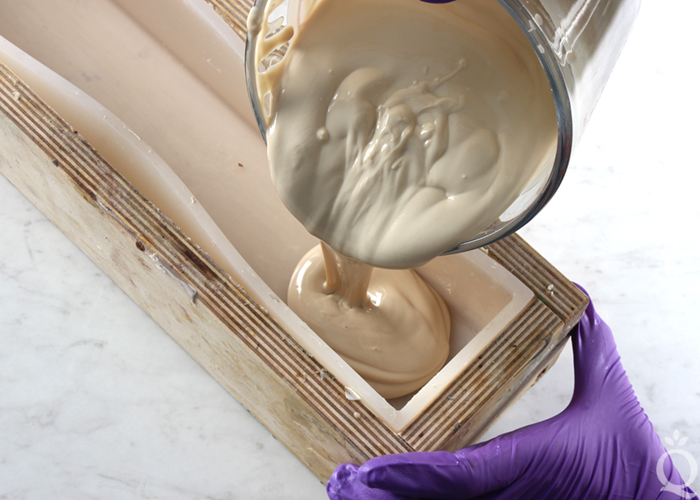 EIGHT: Pour half of the black soap onto the white. Be careful not to let the black soap fall through the first layer of white. Use a spoon to gently cover the white soap. Use the spoon to spread it evenly, and to give it texture.
EIGHT: Pour half of the black soap onto the white. Be careful not to let the black soap fall through the first layer of white. Use a spoon to gently cover the white soap. Use the spoon to spread it evenly, and to give it texture.
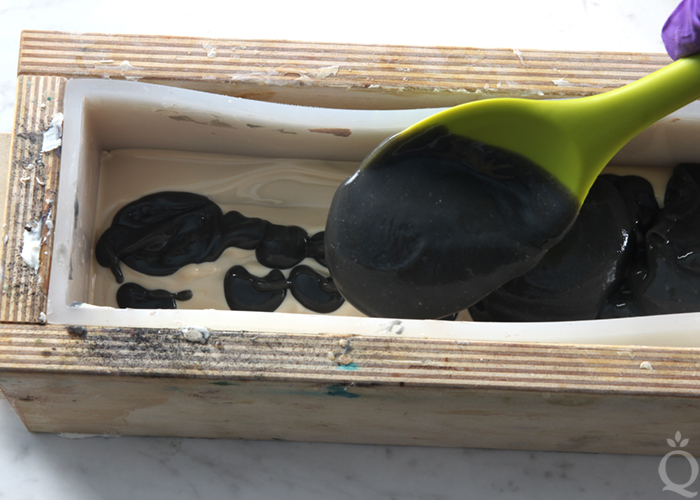
NINE: Cover the black soap with half of the purple soap. Again, use a spoon to spread it evenly and create texture. Tap the mold firmly on the counter to help evenly disperse the soap and get rid of bubbles.
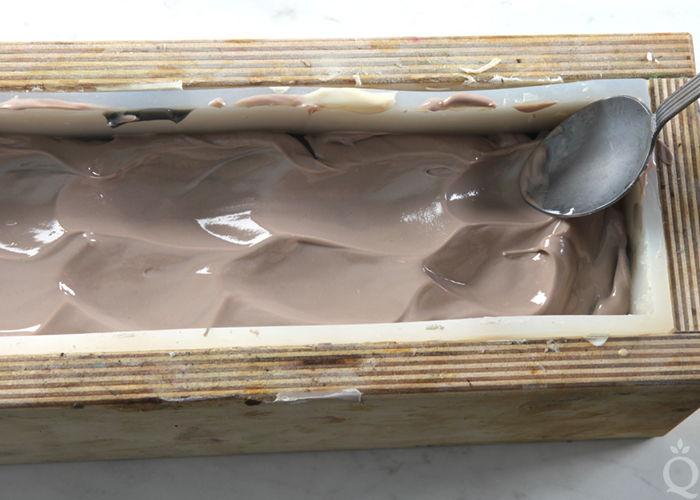
TEN: Continue to layer the soap into the mold with the same color sequence: white soap, black soap, purple soap. Use up all of the remaining soap for the second layer.
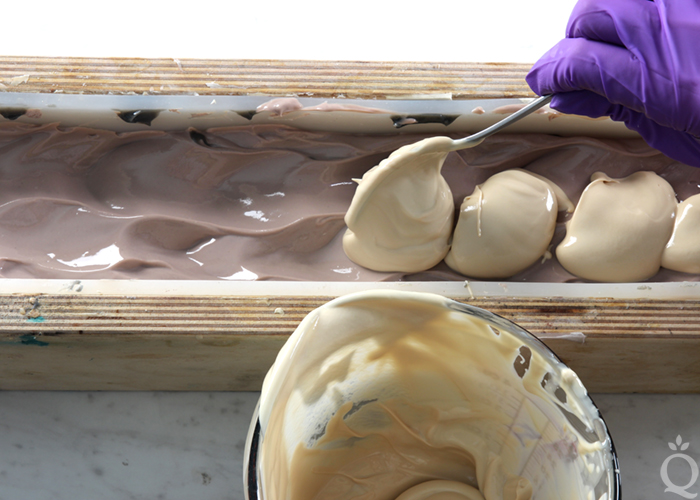
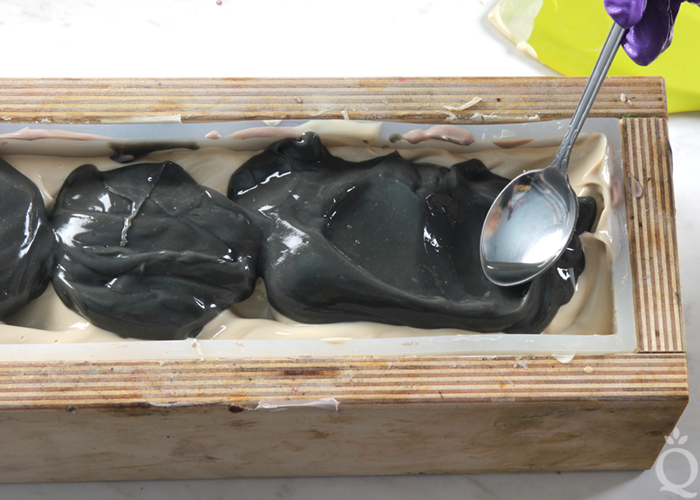
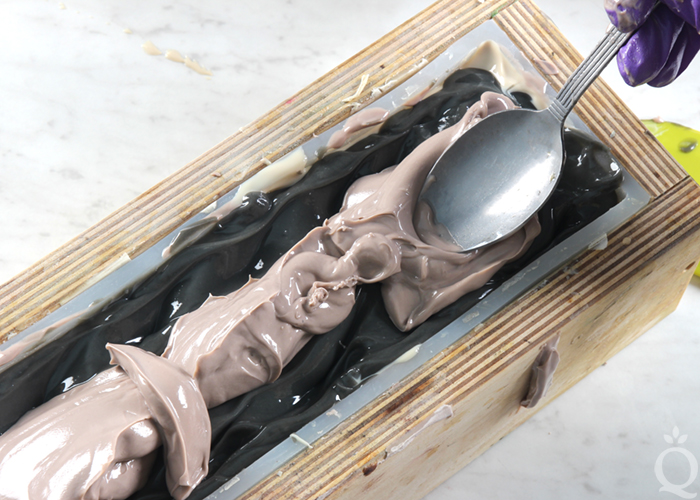
ELEVEN: Once the last of the purple soap is poured into the soap, use a spoon to mound the soap in the center and create peaks. There is no right or wrong way to do this, so just have fun with it!
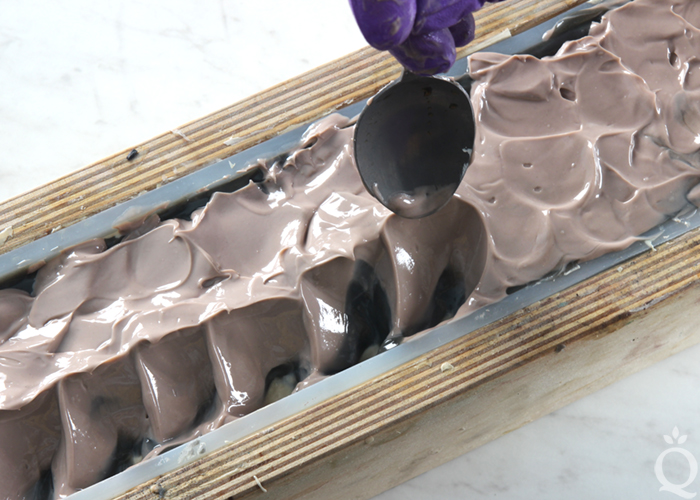
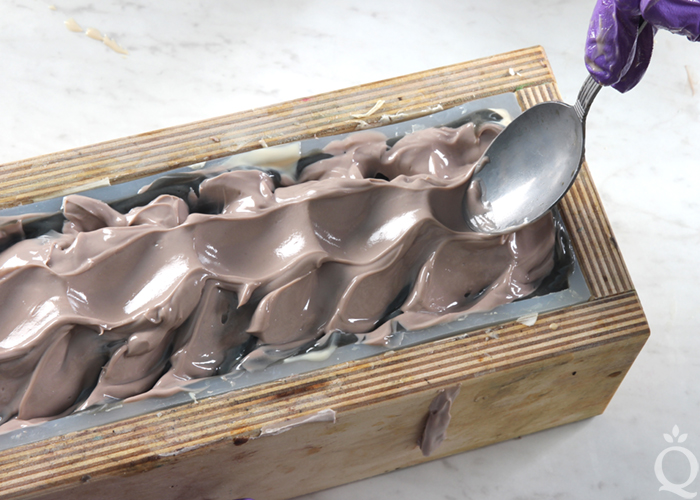
TWELVE: Once you’re happy with the top, sprinkle the used black tea leaves down the center of the soap. Lightly press them (with gloves on) into the soap to help them stick once cut. Spritz the top with 99% isopropyl alcohol to prevent soda ash. Because this soap has a tendency to form glycerin rivers, keep it cool. Do not cover or insulate. If you live in a hot climate, consider placing the soap in the fridge or freezer for several hours to keep it cool. After about 2-3 days, unmold the soap and cut into bars. Allow to cure for 4-6 weeks. Because it does have a heavy water discount, 4 weeks should do the trick. Enjoy!
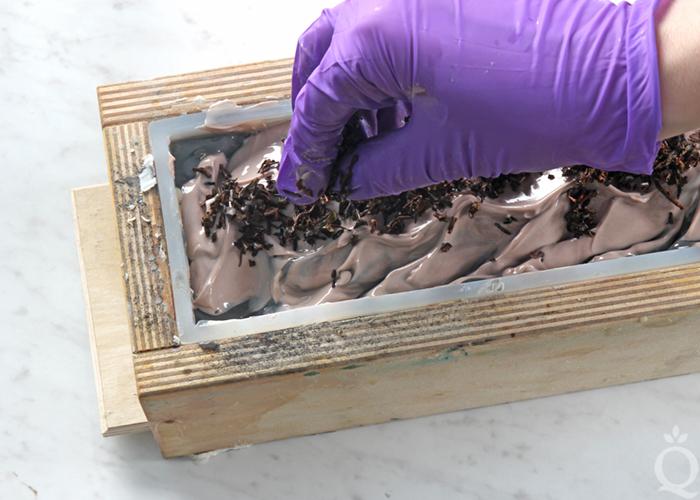
Black Tea Soap Tutorial
- 5 Pound Mold with Sliding Bottom
- Silicone Liner for 5 Pound Mold
- 2.7 oz. Cocoa Butter (5%)
- 13.5 oz. Coconut Oil (25%)
- 2.7 oz. Matcha Green Tea Butter (5%)
- 16.2 oz. Olive Oil (30%)
- 13.5 oz. Palm Oil (25%)
- 5.4 oz. Sweet Almond Oil (10%)
- 14.3 oz. Brewed Black Tea (20% water discount)
- 7.6 oz. Sodium Hydroxide Lye
- 2 oz. Bergamot Black Tea Fragrance Oil
- Titanium Dioxide
- Activated Charcoal
- Purple Brazilian Clay
- Black Tea Leaves (for the top & to brew tea)
- Large Sealable Tea Bag (for brewing tea)
- Slowly and carefully add the lye to the black tea and gently stir until the lye has fully dissolved. The mixture will be a brown color. Do not panic. That's what the titanium dioxide is for. Set aside to cool.
- Fully melt the coconut oil, olive oil, cocoa butter, matcha green tea butter, sweet almond oil, and palm oil. Remember to fully melt and then mix your entire container of palm oil before portioning. Once the lye water and the oils have cooled to 130 degrees or below (and are ideally within 10 degrees of each other), add the lye to the oils and stick blend until you have a thin trace. If you'd like a harder bar of soap that releases faster from the mold, you can add sodium lactate to the cooled lye water. Use 1 teaspoon of sodium lactate per pound of oils in the recipe. For this recipe, you'd add about 3.5 tsp. of sodium lactate.
- Once you reach a very thin trace, add all the Bergamot Black Tea Fragrance Oil. It's okay to add the fragrance at the beginning because it behaves very well in soap.
- Split off about 26 ounces of soap into a separate container. Add 2 teaspoons of dispersed activated charcoal, and use a whisk to fully mix in. Set aside.
- Add all the dispersed titanium dioxide into the large amount of remaining soap. Use the stick blender to fully incorporate the titanium dioxide. Then split the batch in half. Each should weigh about 26 ounces. Add all the dispersed purple Brazilian clay to one container. Use the stick blender to incorporate the clay. Leave the other container of soap uncolored.
- Now it's time to start layering! First, make sure all the colors of soap are a medium to thick trace. Stick blend each from lightest to darkest until a medium to thick texture is achieved. Because they all have different amounts of various colorants, they may thicken at different rates.
- Once you're happy with the texture of each color, pour half of the uncolored soap into the mold and use a spoon to even it throughout the mold. Use the spoon to give the layer texture, because this design does not need exact straight layers.
- Pour half of the black soap onto the white. Be careful not to let the black soap fall through the first layer of white. Use a spoon to gently cover the white soap. Use the spoon to spread it evenly, and to give it texture.
- Cover the black soap with half of the purple soap. Again, use a spoon to spread it evenly and create texture. Tap the mold firmly on the counter to help evenly disperse the soap and get rid of bubbles.
- Continue to layer the soap into the mold with the same color sequence: white soap, black soap, purple soap. Use up all of the remaining soap for the second layer.
- Once the last of the purple soap is poured into the soap, use a spoon to mound the soap in the center and create peaks. There is no right or wrong way to do this, so just have fun with it!
- Once you're happy with the top, sprinkle the used black tea leaves down the center of the soap. Lightly press them (with gloves on) into the soap to help them stick once cut. Spritz the top with 99% isopropyl alcohol to prevent soda ash. Because this soap has a tendency to form glycerin rivers, keep it cool. Do not cover or insulate. If you live in a hot climate, consider placing the soap in the fridge or freezer for several hours to keep it cool. After about 2-3 days, unmold the soap and cut into bars. Allow to cure for 4-6 weeks. Because it does have a heavy water discount, 4 weeks should do the trick. Enjoy!
3.3.3077
The post Black Tea Soap Tutorial appeared first on Soap Queen.
Keine Kommentare:
Kommentar veröffentlichen